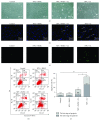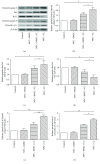Mesenchymal Stem Cells Protect Nucleus Pulposus Cells from Compression-Induced Apoptosis by Inhibiting the Mitochondrial Pathway
- PMID: 29387092
- PMCID: PMC5745742
- DOI: 10.1155/2017/9843120
Mesenchymal Stem Cells Protect Nucleus Pulposus Cells from Compression-Induced Apoptosis by Inhibiting the Mitochondrial Pathway
Abstract
Objective: Excessive apoptosis of nucleus pulposus cells (NPCs) induced by various stresses, including compression, contributes to the development of intervertebral disc degeneration (IVDD). Mesenchymal stem cells (MSCs) can benefit the regeneration of NPCs and delay IVDD, but the underlying molecular mechanism is poorly understood. This study aimed to evaluate the antiapoptosis effects of bone marrow-derived MSC (BMSC) on rat NPCs exposed to compression and investigate whether the mitochondrial pathway was involved.
Methods: BMSCs and NPCs were cocultured in the compression apparatus at 1.0 MPa for 36 h. Cell viability, apoptosis, mitochondrial function, and the expression of apoptosis-related proteins were evaluated.
Results: The results showed that coculturing with BMSCs increased the cell viability and reduced apoptosis of NPCs exposed to compression. Meanwhile, BMSCs could relieve the compression-induced mitochondrial damage of NPCs by decreasing reactive oxygen species level and maintaining mitochondrial membrane potential as well as mitochondrial integrity. Furthermore, coculturing with BMSCs suppressed the activated caspase-3 and activated caspase-9, decreased the expressions of cytosolic cytochrome c and Bax, and increased the expression of Bcl-2.
Conclusions: Our results suggest that BMSCs can protect against compression-induced apoptosis of NPCs by inhibiting the mitochondrial pathway and thus enhance our understanding on the MSC-based therapy for IVDD.
Figures






Similar articles
-
Therapeutic effect of co-culture of rat bone marrow mesenchymal stem cells and degenerated nucleus pulposus cells on intervertebral disc degeneration.Spine J. 2021 Sep;21(9):1567-1579. doi: 10.1016/j.spinee.2021.05.007. Epub 2021 May 14. Spine J. 2021. PMID: 34000376
-
Bone marrow mesenchymal stem cells slow intervertebral disc degeneration through the NF-κB pathway.Spine J. 2015 Mar 1;15(3):530-8. doi: 10.1016/j.spinee.2014.11.021. Epub 2014 Nov 29. Spine J. 2015. PMID: 25457469
-
[An in vitro study on human bone marrow mesenchymal stem cells protecting nucleus pulposus cells from oxidative stress-induced apoptosis in a co-culture system of no direct cellular interaction].Zhongguo Xiu Fu Chong Jian Wai Ke Za Zhi. 2010 Apr;24(4):391-8. Zhongguo Xiu Fu Chong Jian Wai Ke Za Zhi. 2010. PMID: 20458997 Chinese.
-
CsA attenuates compression-induced nucleus pulposus mesenchymal stem cells apoptosis via alleviating mitochondrial dysfunction and oxidative stress.Life Sci. 2018 Jul 15;205:26-37. doi: 10.1016/j.lfs.2018.05.014. Epub 2018 May 8. Life Sci. 2018. PMID: 29746847
-
Wharton's Jelly-derived mesenchymal stem cells suppress apoptosis of nucleus pulposus cells in intervertebral disc degeneration via Wnt pathway.Eur Rev Med Pharmacol Sci. 2020 Oct;24(19):9807-9814. doi: 10.26355/eurrev_202010_23190. Eur Rev Med Pharmacol Sci. 2020. PMID: 33090383
Cited by
-
Tunneling Nanotube-Mediated Mitochondrial Transfer Rescues Nucleus Pulposus Cells from Mitochondrial Dysfunction and Apoptosis.Oxid Med Cell Longev. 2022 Mar 4;2022:3613319. doi: 10.1155/2022/3613319. eCollection 2022. Oxid Med Cell Longev. 2022. PMID: 35281461 Free PMC article.
-
Role of Caspase Family in Intervertebral Disc Degeneration and Its Therapeutic Prospects.Biomolecules. 2022 Aug 4;12(8):1074. doi: 10.3390/biom12081074. Biomolecules. 2022. PMID: 36008968 Free PMC article. Review.
-
Heme Oxygenase-1-Mediated Autophagy Protects against Oxidative Damage in Rat Nucleus Pulposus-Derived Mesenchymal Stem Cells.Oxid Med Cell Longev. 2020 Feb 25;2020:9349762. doi: 10.1155/2020/9349762. eCollection 2020. Oxid Med Cell Longev. 2020. PMID: 32184919 Free PMC article.
-
Exosomes from umbilical cord mesenchymal stem cells ameliorate intervertebral disc degeneration via repairing mitochondrial dysfunction.J Orthop Translat. 2024 May 27;46:103-115. doi: 10.1016/j.jot.2023.10.004. eCollection 2024 May. J Orthop Translat. 2024. PMID: 38841339 Free PMC article.
-
NF-κB signalling pathways in nucleus pulposus cell function and intervertebral disc degeneration.Cell Prolif. 2021 Jul;54(7):e13057. doi: 10.1111/cpr.13057. Epub 2021 May 24. Cell Prolif. 2021. PMID: 34028920 Free PMC article. Review.
References
LinkOut - more resources
Full Text Sources
Other Literature Sources
Research Materials

